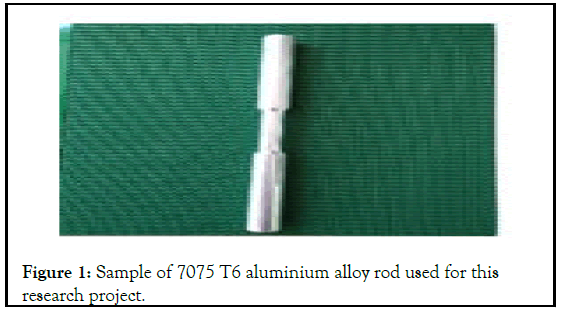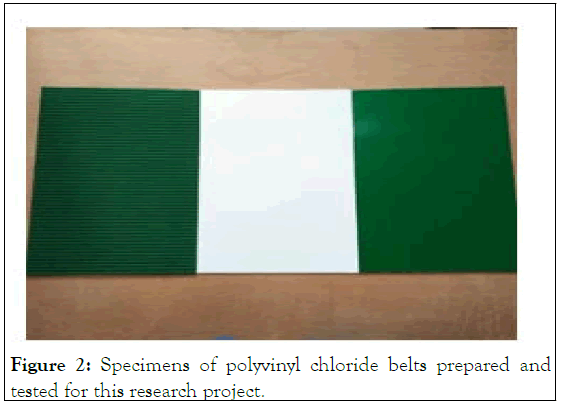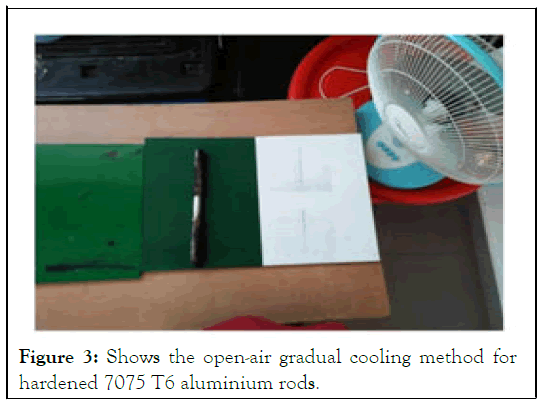Research Article - (2023)Volume 12, Issue 2
The Effects of Gradual Cooling towards Mechanical Behaviour of 7075 T6 Aluminium Rods and Polyvynil Chloride Belts
Vikneshwaran Viknesh* and Azizul RahmanAbstract
This paper reports the effects of hardening heat treatment and gradual cooling on the mechanical properties of 7075 temper grade 6 aluminium alloys and polyvinyl chloride conveyor belt. The aluminium alloys casted in the form of round cylindrical rods. Upon casting, the rods machined into dog-bone style prior to the heat treatment and tensile test. The samples attempted hardening treatment at desired temperatures. A time vs. temperature plotted prior to the hardening treatment effect. The samples subjected to gradually cooling, by releasing the heat on the surface of some polyvinyl chloride conveyor belts. Upon accomplishment, entire as-cast samples in each category and heat-treated samples subjected to tensile test. From the results obtained, there is improvement of mechanical properties because of gradual cooling.
Keywords
Heat treatment; Mechanical properties; Polyvinyl chloride conveyor belt; 7075 T6 Aluminium rod
Introduction
7075 grade aluminium and polyvynil chloride conveyor belts
7075 aluminium alloy has highly opted for structural applications. 7075 grade has been a mutual choice of raw material selection for heavy-duty manufacturing sectors and construction industries. The core reason is 7075 aluminium Alloys belongs to low density, highest tensile strength, ductile and huge fatigue resistant [1]. Conveyor belts considered as high power conveyance medium that widely applied in manufacturing sectors. The stiff structure and economic adaptability of the manufactured conveyor belts is the core reason for the mutual choice for bulk transportation of conveying products. Especially, polyvinyl chloride conveyor belts suit better for the requirement of bulk transportation in various manufacturing industries. Moreover, polyvinyl chloride belts are also cost-effective and highly durable [2].
Materials and Methods
Facility
During early stage of this research, it required to analyze the suitable experimental data’s and choose the facilities for the heat treatment and tensile test process for 7075 T6 aluminium alloy. The machines used for the experiments are heat treating furnace, and universal testing machine. The UTM (Ultimate Tensile Strength) machine was very useful to conduct the tensile test for hardened 7075 T6 aluminium rods. The entire machines well calibrated before the experiment conducted [3].
Research design for 7075 T6 aluminium rod
As an initial sample preparatory process, four pieces of 7075 aluminium T6 rods were cast in a round cylindrical rod shape. Upon casting, the rods converted into dog-bone shape using a lathe machine for the convenience of the tensile testing procedure.
The machining process accomplished according to a reference of a dimensional diagram (Figure 1 and Table 1) [4].

Figure 1: Sample of 7075 T6 aluminium alloy rod used for this research project.
| Aluminium casting details | |
|---|---|
| Material | 7075 T6 aluminium rod |
| Dimension | 300 mm × 20 mm |
| Quantity | 3 pieces |
Table 1: Tabulation of 7075 T6 aluminium casting and preparatory details.
Research design for polyvinyl chloride belts
As a preparatory process, three sets of polyvinylchloride conveyor belts were prepared according to the required dimensions. For each set 3 pieces of belts were joint through the overlapping method. The core reason for applying this method is to increase the thermal conductivity level.
Through the overlapping method, the thickness of the belt also increases which turns advantageous for the belts to prevent itself from melting. For each set of the belt, I ensured that the thickness complies with the average thickness of the high-temperature resistant belt (Figure 2 and Table 2) [5].

Figure 2: Specimens of polyvinyl chloride belts prepared and tested for this research project.
| Type of conveyor belt | Thickness | Overlapped quantity | Total thermal conductivity | Total dimension (L × W) |
|---|---|---|---|---|
| 3Ply PVC smooth green | 3.2 mm (each) | 3 | 210°C | 900 mm × 750 mm |
| 3 Ply PVC rough top rubber green | 5.4 mm (each) | 3 | 210°C | 900 mm × 750 mm |
| 2 Ply PVC diamond pattern white | 2.0 mm (each) | 3 | 240°C | 900 mm × 750 mm |
Table 2: Tabulation of polyvinyl chloride conveyor belts.
Hardening treatment
As an initial process, hardening treatment conducted for three specimens under respective temperatures. A time vs. temperature graph plotted to conduct the hardening treatment without any flaw [6].
Gradual cooling method
The cooling process for the hardened aluminium rods conducted by releasing the heat on the surface of polyvinyl chloride conveyor belts at the open environment. The concentration of air from a cooling fan placed aside also increased the cooling force and reduced the heat more rapidly. Because of this cooling method, the conveyor belts top coatings and surface pattern attempted certain thermal effect at a certain area. This happened due to thermal penetration after immediate contact of the aluminium rod’s heated surface (Figure 3) [7].

Figure 3 Shows the open-air gradual cooling method for hardened 7075 T6 aluminium rods.
Results and Discussion
Mechanical properties of 7075 T6 aluminium rods
According to my first research objective, the experiment conducted to test the similarity of the mechanical properties obtained by after implementation gradual cooling for the samples of 7075 T6 aluminium rods underwent hardening treatment [8]. As estimated, the mechanical properties of the gradually cooled samples have improved well compared to existing reference data from. Most importantly, the maximum tensile strength achieved by the 7075 T6 aluminium rods underwent hardening treatment has increased from the existing data value of 603 MPA to 645.22 MPA. This result also sets the record of highest value achieved among the three sets of tested specimens. This proves that the maximum stiffness value obtained by the aluminium rod to withstand before breaking has improved well. This improvement also revises the sustainability in terms of plastic deformation limit level of the aluminium rod [9].
Also, the specimen attempted gradual cooling upon hardening treatment at the lowest temperature of 100°C has achieved the highest tensile strength compared other consecutive temperatures. This value also has defeated the tensile strength value of reference specimen with 120°C and boosted by 42.22 MPA. Hence, proved that my first objective successfully achieved. Whereby, the gradual cooling method for hardened 7075 T6 aluminium rod able to elevate the tendency of its structural stiffness and deformation limit compared to results of the rapid cooling process [10].
Fatigue failure of 7075 T6 aluminium rods
According to my second research objective, the experiment conducted to test the similarity of fatigue failure results obtained by upon undergoing a tensile test. As estimated, the mechanical properties of the gradually cooled samples have improved well. However, fluctuates as the temperature increases. Moreover, the fracture pattern obtained by actual results is brittle fracture for entire specimens. These results also match with the cracking cleavage formed at the fractured surfaces. Especially, for rods attempted 100°C as and 200°C as shown in the cleavage fracture pattern is very steep. However, for rod underwent 150°C as shown in the fracture pattern varies compared to the other two rods. Because the cleavage crack is not looking steeper similarly with the other two rods undergone 100°C and 200°C. For 100°C and 200°C cleavage cracking have occurred during the brittle fracture portrays that this is a result of trans-granular fracture which most likely occurs when the plastic flow is restricted [11]. This has also increased the toughness level of the aluminium rod. Additionally, the cross-sectional area of the cracked portion has diminished significantly, which caused by lack of necking and reduction at the slip system. Hence, proved as toughness level increases, aluminium rods can adapt brittle characteristics even though they are not naturally brittle. Aluminium also tends to exert a brittle behaviour at minimal temperatures. The effect of gradually cooled 7075 T6 aluminium rods on surfaces of polyvinyl chloride conveyor belts. According to my third research objective, the experiment conducted to test the tendency of polyvinyl chloride conveyor belts to withstand the penetration of heat released by the 7075 T6 aluminium rods upon hardening treatment [12].
As estimated, the mechanical properties of the gradually cooled samples have improved well. However, the sustainability of the PVC Conveyor belts still observed. Especially on the surface deformation of each conveyor belts. These results have produced various structural deformation but failed to attempt any structural damage such as melting. As a positive sign, those tested PVC belts proved that still able to compete with hightemperature resistant belts in withstanding penetration of heat release in a conditional environment such as open air cooling atmosphere, unlike furnace cooling. Especially, for PVC belts attempted 100°C as shown in until 2.6 the belts surface attempted change in surface colour without allowing any other structural deformation such as dent or swelling. Clearly understood that the impact modifier of these conveyor belts protects the PVC belts to withstand penetrations without causing fractures or deformations during usage. However, for PVC belts allowed 150°C of heat release as shown in until 2.9 the surface pattern varies compared to 100°C. Because the impact of slightly higher thermal contact has caused mild structural deformation on the surface of the PVC belts. Whereby, the surface of the belts swelled specifically at the thermal contacted area. From observation, understood that for this thermal effect when the PVC belts allow heating at the rising temperature the movements of molecules energy turn huge in amount compared to intermolecular forces. Due to this, molecular distances between the top coatings increases and resins become soft [13].
Lastly, for PVC belts allowed 200°C of heat release as shown in until 3.2. The surfaces attempted huge deformation. The condition of dent marks and structural deformation at the concentrated area is huge compared to belts attempted 100°C and 150°C. The structural deformation increased beyond limit till the top coatings have changed in shape and colour from the original. Clearly understood that the impact modifiers have failed to prevent the belts, stiffness of the product to suppress creeping, warping, and sagging under penetration of heat at the concentrated area. Upon all those observations, clearly understood that the approach of conducting open environmental cooling added with a cooling fan has eased the heat to release fast. This implementation also turns advantage to prevent the conveyor belts from overall melting. Hence, proved that the stabilizers of the PVC Belts protected the continuous reaction of polyvinyl chloride from the decomposing process. It helps the physical properties to resist weather, heat ageing and sunlight when the heat rises above 80°C. Even though certain area was affected due to the substances such as stabilizers and impact modifiers has failed at the utmost penetration of heat at 200°C [14].
Conclusion
First, I would confidently mention that the research objectives achieved without any technical flaw. Tensile Test results for hardened 7075 T6 aluminium rods, obtained according to standard specifications and parameters. Through the results, I witnessed that the mechanical properties have improved better in numerical values especially on tensile strength compared to reference data stated in the literature review. The boosted value of tensile strength for entire specimens has endorsed that the maximum stiffness of the aluminium rods to undergo plastic deformation has improved. Besides, the method conducted for gradual cooling using polyvinyl chloride conveyor belts has completed successfully without melting. The prevention strategy from melting such as increasing the thickness averagely similarly to a high temperature resistant belt made of materials such nomex, polyester has cooperated to withstand the penetration of heat at the concentrated area of the polyvinyl chloride belt. This research method also prevents the 7075 T6 aluminium rods from attempting wear and corrosion.
To conclude my research, I endorse that 7075 T6 series aluminium is vastly versatile compared to other aluminium series. The mechanical properties such relatively high strength in tension, compression and shear. 7075 T6 series own high corrosion resistance and toughness compared with other grades of aluminium. Compared to results of rapid cooling results in reference data, the gradual cooling method has performed well and proved as the right choice to improve the mechanical properties especially the tensile strength of 7075 T6 aluminium rods. Polyvinyl chloride conveyor belts proved that it could replace costly high-temperature resistant belts to support gradual cooling method in safer and wear the freeway to ensure the surface of 7075 T6 aluminium rods are smooth and shining.
Acknowledgement
First and foremost, my sincere gratitude to city university management for providing me a platform to accomplish my postgraduate degree. My special thanks to respected lectures of mechanical engineering faculty for delivering essential knowledge and guidance from the stage of thesis development until accomplishment of project. My special address to project supervisors. I truly appreciate the professional guidance delivered by them towards improvising my project objectives and methodology. The techniques proposed by them supported a lot in order to ensure my project outcome is relevant to the metallurgical sector in engineering field. Lastly, my sincere thanks for their kind support in arranging facilities to execute the mechanical testing are applicable to achieve the objectives of my research. I assure that will grasp more on the research techniques and machine handling skills adapted from them in my future endeavors.
References
- Isadare AD, Aremo B, Adeoye MO, Olawale OJ, Shittu MD. Effect of heat treatment on some mechanical properties of 7075 Aluminium alloy. Mat Res. 2003;16:190-194.
- Leong IK. Aluminium 7075-T6 cyclic fatigue testing at elevated temperatures. Project Report, University of New South Wales at the Australian Defence Force Academy, Australia, 2014, pp. 1-30.
- Mohan K, Suresh JA, Ramu P, Jayaganthan R. Microstructure and mechanical behavior of al 7075-T6 subjected to shallow cryogenic treatment. J Mat Eng Perform. 25(6):2185-2194.
- Chen DC, You CS, Gao FY. Analysis and experiment of 7075 aluminum alloy tensile test. Procedia Eng. 2014;81:1252-1258.
- Mary S, Neumark-Sztainer D, French S. Individual and environmental influences on adolescent eating behaviors. J Am Diet Assoc. 2002;102(3):40-51.
[Crossref] [Google Scholar] [PubMed]
- Baiphethi MN, Jacobs PT. The contribution of subsistence farming to food security in south Africa. Agrekon. 2009;48(4):459-482.
- Devi S, Singh LK. Zero energy cool chamber, low cost storage structure for vegetables and fruits in Churachandpur district of Manipur. J Krishi Vigyan. 2018;7(1):216-219.
- Eastman K. Health promoting phytochemicals in vegetables. Hortic Rev. 2002;28:124-125.
- Xue L, Liu G, Parfitt J, Liu X, van Herpen E, Stenmarck A, et al. Missing food, missing data? A critical review of global food losses and food waste data. Env Sci Technol. 2017;51(12):6618-6633.
[Crossref] [Google Scholar] [PubMed]
- Munesue Y, Masui T, Fushima T. The effects of reducing food losses and food waste on global food insecurity, natural resources, and greenhouse gas emissions. Env Eco Polic Stud. 2014;17:43-77.
- Hodges RJ, Buzby JC, Bennett B. Postharvest losses and waste in developed and less developed countries: Opportunities to improve resource use. J Agric Sci. 2010;149(S1):37-45.
- Kader A. Increasing food availability by reducing postharvest losses of fresh produce. Int Postharv Sympo. 2004;682:2169-2175.
- Kaur J, Aslam R, Saeed P. Storage structures for horticultural crops: A review. Environ Conserv J. 2021;22:95-105.
- Shafiee-Jood M, Cai X. Reducing food loss and waste to enhance food security and environmental sustainability. Environ Sci Technol. 2016;50(16):8432-8443.
[Crossref] [Google Scholar] [PubMed]
Author Info
Vikneshwaran Viknesh* and Azizul RahmanCitation: Viknesh V, Rahman A (2023) The Effects of Gradual Cooling towards Mechanical Behaviour of 7075 T6 Aluminium Rods and Polyvynil Chloride Belts. Global J Eng Des Technol. 12:176.
Received: 21-Sep-2020, Manuscript No. GJEDT-23-6559; Editor assigned: 24-Sep-2020, Pre QC No. GJEDT-23-6559; Reviewed: 08-Oct-2020, QC No. GJEDT-23-6559; Revised: 17-Apr-2023, Manuscript No. GJEDT-23-6559; Published: 15-May-2023 , DOI: 10.35248/2319-7293.23.12.176
Copyright: © 2023 Viknesh V, et al. This is an open-access article distributed under the terms of the creative commons attribution license which permits unrestricted use, distribution and reproduction in any medium, provided the original author and source are credited.